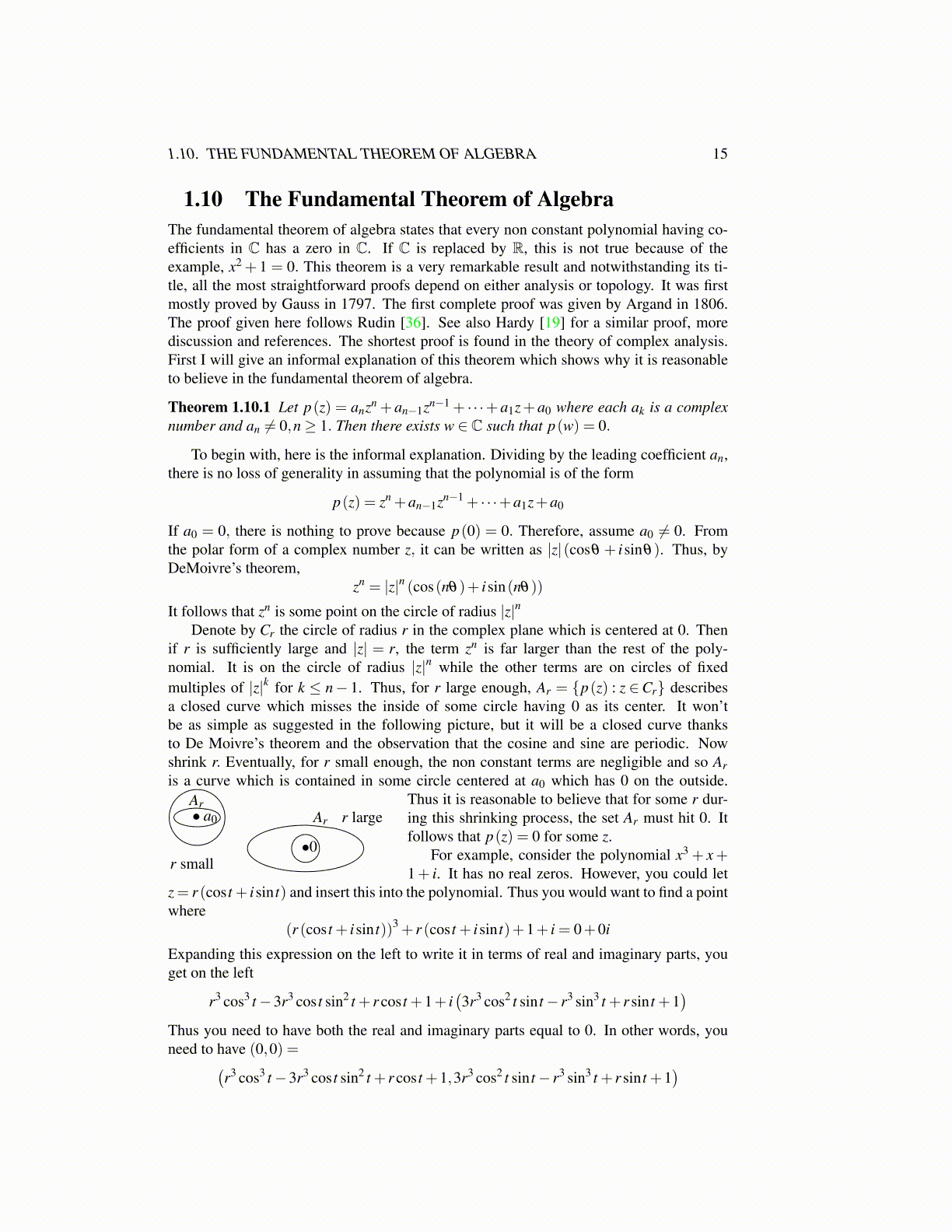
1.10. THE FUNDAMENTAL THEOREM OF ALGEBRA 15
1.10 The Fundamental Theorem of AlgebraThe fundamental theorem of algebra states that every non constant polynomial having co-efficients in C has a zero in C. If C is replaced by R, this is not true because of theexample, x2 + 1 = 0. This theorem is a very remarkable result and notwithstanding its ti-tle, all the most straightforward proofs depend on either analysis or topology. It was firstmostly proved by Gauss in 1797. The first complete proof was given by Argand in 1806.The proof given here follows Rudin [36]. See also Hardy [19] for a similar proof, morediscussion and references. The shortest proof is found in the theory of complex analysis.First I will give an informal explanation of this theorem which shows why it is reasonableto believe in the fundamental theorem of algebra.
Theorem 1.10.1 Let p(z) = anzn + an−1zn−1 + · · ·+ a1z+ a0 where each ak is a complexnumber and an ̸= 0,n≥ 1. Then there exists w ∈ C such that p(w) = 0.
To begin with, here is the informal explanation. Dividing by the leading coefficient an,there is no loss of generality in assuming that the polynomial is of the form
p(z) = zn +an−1zn−1 + · · ·+a1z+a0
If a0 = 0, there is nothing to prove because p(0) = 0. Therefore, assume a0 ̸= 0. Fromthe polar form of a complex number z, it can be written as |z|(cosθ + isinθ). Thus, byDeMoivre’s theorem,
zn = |z|n (cos(nθ)+ isin(nθ))
It follows that zn is some point on the circle of radius |z|nDenote by Cr the circle of radius r in the complex plane which is centered at 0. Then
if r is sufficiently large and |z| = r, the term zn is far larger than the rest of the poly-nomial. It is on the circle of radius |z|n while the other terms are on circles of fixedmultiples of |z|k for k ≤ n− 1. Thus, for r large enough, Ar = {p(z) : z ∈Cr} describesa closed curve which misses the inside of some circle having 0 as its center. It won’tbe as simple as suggested in the following picture, but it will be a closed curve thanksto De Moivre’s theorem and the observation that the cosine and sine are periodic. Nowshrink r. Eventually, for r small enough, the non constant terms are negligible and so Aris a curve which is contained in some circle centered at a0 which has 0 on the outside.
•0
Ar r large• a0
Ar
r small
Thus it is reasonable to believe that for some r dur-ing this shrinking process, the set Ar must hit 0. Itfollows that p(z) = 0 for some z.
For example, consider the polynomial x3 + x+1+ i. It has no real zeros. However, you could let
z= r (cos t + isin t) and insert this into the polynomial. Thus you would want to find a pointwhere
(r (cos t + isin t))3 + r (cos t + isin t)+1+ i = 0+0i
Expanding this expression on the left to write it in terms of real and imaginary parts, youget on the left
r3 cos3 t−3r3 cos t sin2 t + r cos t +1+ i(3r3 cos2 t sin t− r3 sin3 t + r sin t +1
)Thus you need to have both the real and imaginary parts equal to 0. In other words, youneed to have (0,0) =(
r3 cos3 t−3r3 cos t sin2 t + r cos t +1,3r3 cos2 t sin t− r3 sin3 t + r sin t +1)